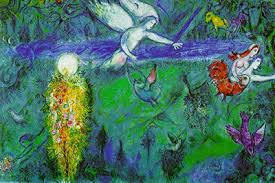Never exposed to art during his childhood, Chagall became fascinated with painting and drawing while a student; this began a lifelong obsession.
Although Chagall dabbled with naturalistic portrait painting early on in his career, it was not long before he came to the realisation that his true calling lay very much outside of artistic tradition.
He was also a victim of anti-Semitism, something which kept countless Jews out of the artistic world. Chagall had little choice but to innovate.
Chagall quickly became known for his fragmented, confrontational canvases. Although his subject matter tended towards portraits and still lives, his technique was radical and uncompromising.
Chagall had little reluctance to throw away the artistic traditions of the nineteenth century and let raw emotion pour forth from each one of his paintings.
In doing so, he showed his fellow Modernists new ways of working - new ways of creating art. Chagall's artwork put him on the wrong side of the Nazis, once they had taken over his adopted homeland of France: the Nazi authorities deemed his paintings to be "degenerate", and he was forced to flee to the United States before returning to France three years after the war had ended.
With "Adam and Eve", Chagall offers the viewer his own distinctive interpretation of a very familiar subject: the Genesis story and the Garden of Eden. The painting depicts the first couple in the process of being chased from the garden by an angel - but in a way that defies tradition.
Chagall's departure from orthodoxy is perhaps signified by the sword wielded by the angel, which is blue - a distinct contrast to the flaming sword described in the Bible. The animals of Eden, rather than being recognisable ancestors to those on Earth, are portrayed as weird, amorphous things, neither one species nor the other.
A third human figure can be seen to the left, partially blending in with the greenery and apparently in flight from the angel, albeit in a different direction to Adam and Eve. Could this be Chagall's vision of the Devil, looking very different to the traditional serpent? Or was he possibly recalling the Hebrew legend of Lilith, Adam's first wife? The viewer is free to read their own interpretations into the scene - and this subjective element, of course, is one of the key markers of Modernist art.
Nobody who appreciates the significance of twentieth-century Modernist art could fail to find "Adam and Eve" a truly striking canvas. It represents a turbulent time in history, when old artistic traditions were giving way to new methods of seeing and representing the world. Any lover of art cannot help but feel admiration when confronted with such visionary work: Marc Chagall had the gift of turning even the most traditional and familiar subject, such as the Garden of Eden, into his own.
